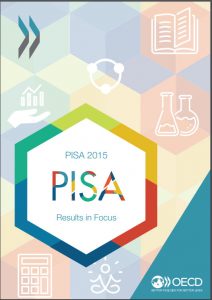Today the results of the 2015 PISA (Program International of Student Assessment) were published. We have been waiting for the results for a long time. As I work with future physics and science teachers, it is not surprising it is very important to me how Canada is doing internationally. While my own children are not in K-12 any longer, I care about thousands of Canadian kids who are attending our schools. I have to admit, that I was happy and even surprised about many of the results concerning the performance of Canadian students in science as I have been a university science prof here, thus I had seen how much undergraduate students struggled with basic math and science. I have to read the report more carefully and I have to pay more attention to the trends, but it looks like Canadian secondary science teachers are doing a good job! More information can be found here: http://s3.documentcloud.org/documents/3232798/Book-PISA2015-en-Dec5.pdf (especially see page 81). On the other hand, the TIMMS results are not so good for Canada – this is a mathematics and science test for younger students. And if you want to know how these tests differ, here is a very useful link: https://theeconomyofmeaning.com/2016/11/27/what-are-the-differences-between-timss-and-pisa/ Food for thought.
Here I am copying the introduction by the OECD Secretary-General Angel Gurria. You can argue about how the results are obtained and dismiss them, but I think it is worth looking at them and at the methodology. I will be discussing it with my own students – future teachers.
Over the past decade, the OECD Programme for International Student Assessment, PISA, has become the world’s premier yardstick for evaluating the quality, equity and efficiency of school systems. By identifying the characteristics of high-performing education systems, PISA allows governments and educators to identify effective policies that they can then adapt to their local contexts. The latest PISA assessment in 2015 focused on science. From taking a painkiller to determining what is a “balanced” meal, from drinking pasteurised milk to deciding whether or not to buy a hybrid car, science is ubiquitous in our lives. And science is not just test tubes and the periodic table; it is the basis of nearly every tool we use – from a simple can opener to the most advanced space explorer. More important, science is not only the domain of scientists. In the context of massive information flows and rapid change, everyone now needs to be able to “think like a scientist”: to be able to weigh evidence and come to a conclusion; to understand that scientific “truth” may change over time, as new discoveries are made, and as humans develop a greater understanding of natural forces and of technology’s capacities and limitations. This brochure highlights some of the results from PISA 2015. PISA shows that every country has room for improvement, even the top performers. With high levels of youth unemployment, rising inequality, a significant gender gap, and an urgent need to boost inclusive growth in many countries, we have no time to lose in providing the best education possible for all students. Angel Gurría OECD Secretary-General “
And this is an interesting paper from CBC about the huge differences among Canadian provinces: Manitoba and Saskatchewan are the most underperforming provinces, while Alberta and BC students are doing exceptionally well: http://www.cbc.ca/news/canada/manitoba/student-assessment-pisa-oecd-manitoba-1.3883344 I would love to know what are the causes of these huge differences. I also would love to know how these results with the general level of mathematics and science knowledge in our countries.
Another interesting link: https://theeconomyofmeaning.com/2013/11/01/so-you-want-to-compare-educational-systems-from-different-countries-where-to-start/

